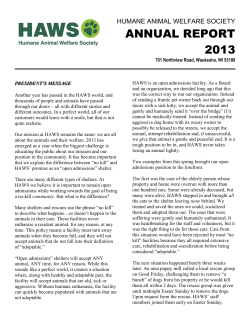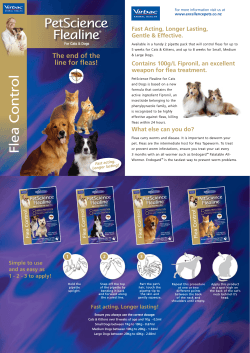
MEGESTROL ACETATE Product Profile and Position Paper
MEGESTROL ACETATE Feb. 2009 Product Profile and Position Paper Megestrol Acetate (MA) is used as an oral contraceptive in female dogs and cats. MA is available in a number of countries under different brand names and in some places as a generic. Alliance for Contraception in Cats & Dogs (ACC&D) www.acc-d.org Megestrol acetate ORAL CONTRACEPTIVE FOR FEMALE DOGS AND CATS INTRODUCTION Megestrol acetate (MA) is one of a group of man-made progestins used to prevent pregnancy and heat cycles n dogs and cats. It has also been prescribed to treat certain skin and behavior problems. MA has been used for dogs and cats over several decades in numerous countries under different brand names and at varying recommended doses. One result of this has been that experiences with and perspectives on the drug vary significantly. In the U.S., for instance, MA is generally viewed as unsafe for cat contraception, whereas European veterinarians are more comfortable with its use. MECHANISM OF ACTION MA acts on the brain to stop or slow the secretion of FSH and LH by the pituitary gland; the release of these two hormones is essential to ovulation and sperm production. As a synthetic progestin that is orally available, MA mimics natural hormones in that its effects spread throughout the body, resulting in side effects or complications. As might be expected, these side effects most often involve the reproductive system, but not exclusively. They are discussed below. HISTORY MA is one of the oldest of the synthetic progestins. In the U.S., starting in 1975, MA was sold as a canine contraceptive under the name Ovaban. Ovaban is no longer produced but generic forms of MA continue to be available in the U.S. MA is also available in Europe, Japan and Australia under a number of different names. Brand names currently or previously available include Megecat®, Ovarid®, Suppress®, Chronopil®, Canipil®, Oestruval 10®, Felipil®, MiniPil®, Pilucalm®, PillKan®, Megedine®, Opochaleurs®, Pruritex®, Estropill®, Estroblock® and Ovaban®. USE AND EFFECTIVENESS DOGS: Early experimental reports found MA to be 92% effective at postponing estrus (heat) in female dogs when it was given at 2.2 mg/kg for 8 days starting at the very beginning of the heat cycle (proestrus). If not started early enough or if started at an insufficient dose, MA does not work. MA postpones estrus for what is approximately an entire reproductive cycle, usually 4-6 months (with a range of 1-7 months). If MA treatment is started when the female dog is not in heat, the reproductive cycle will start shortly after MA is discontinued. To be effective and safe, MA needs to be started at precise times in relation to a bitch’s normal heat cycles. MA should not be used before a bitch’s first cycle (the onset of puberty) or in pregnant bitches, as it can cause Page 1 Alliance for Contraception in Cats & Dogs (ACC&D) www.acc-d.org changes in fetuses. In addition, most veterinarians recommend against using MA for durations longer than two normal cycles. Some experiments showed MA could suppress sperm production and quality in dogs, thus making it a potentially effective male contraceptive. However, effective dosing for this purpose was quite high (20 mg/kg per day). Cats: MA is also effective as a contraceptive in cats, with reports of effective doses ranging from 2.5 mg per week to induction dosing of 5 mg daily for five days, followed by weekly doses of 5 mg. The feline reproductive cycle is a challenge to control because cats do not ovulate unless they are mated (induced ovulation), and they will cycle in and out of heat more or less continuously until they ovulate after mating. Because of this, cats require ongoing treatment with MA during their heat season (January/February to mid-summer in northern temperate regions). The same caveats exist for cats as for dogs: It is important to avoid dosing pre-pubertal cats (cats too young to have started their first heat cycle) and cats that may be pregnant. Use for more than two seasons is not recommended. Non-contraceptive indications: MA has been used in both dogs and cats to treat skin diseases and behavior disorders. Dosages for these indications are much higher than those used for contraception, and durations of treatment can be prolonged. Many of the complications of MA treatment are most likely to arise with use at these higher doses, and these uses have been generally discouraged. COMPLICATIONS Complications of MA use include—but are not limited to—the following: • Pyometra. For dogs, the most important complication of treatment with MA was infection of the uterus (pyometra), severe enough to require hysterectomy. In one study, pyometra occurred in 8 out of 1,000 dogs treated. In a study on cats, pyometra in one cat was reported (0.4% of all cats treated) after treatment with MA at contraceptive doses. • Mammary hyperplasia and cancer. A benign but sometimes irreversible condition of mammary enlargement commonly occurs in cats treated with MA prior to puberty. Use of MA has been implicated in increased rates of mammary cancers in dogs and cats. • Diabetes mellitus. Cats treated with MA and other synthetic progestins sometimes develop diabetes mellitus that may or may not resolve after halting therapy. This has occurred at rates reportedly as high as 5% and 10% when cats are treated at higher doses (5 mg/cat daily for one to two weeks). • Adrenal gland suppression. The adrenal gland produces hormones that aid in the body’s response to stress. Experiments have shown that MA suppresses the adrenal gland. This effect, however, has not resulted in signs of disease with clinical use. • Behavioral changes . Weight gain and lethargy, as well as other behavioral changes, are commonly reported. Page 2 Alliance for Contraception in Cats & Dogs (ACC&D) • www.acc-d.org Fetal and pregnancy development. Delayed onset of birth and masculinization of female fetuses may occur when MA is administered to pregnant animals. European experience. A large retrospective study examining thousands of cats treated with MA at low contraceptive doses over several years found the incidence of complications to be very rare. CONCLUSION MA retains a poor reputation in the U.S. that it may not deserve. Used correctly under specific circumstances (by attentive owners over short time periods on pets intended for breeding), MA can provide relatively safe postponement of estrus and temporary prevention of pregnancy. However, its usefulness for free-roaming animals is limited, for several reasons: • MA has not proven to be without complications and is associated with health and behavioral changes. Free-roaming cats and dogs—particularly those which are not social with humans—cannot be monitored for signs of complications in the way an owned house-pet can. • MA must be given orally and at specific doses, making the drug difficult or impossible to safely administer outside and/or to more than one animal. The cats may get too much or too little of the drug, and there is substantial risk of unintended exposure to non-target animals (such as wild animals and neighboring pets). • For safety and efficacy, MA requires careful timing that considers life stage, body weight and reproductive cycling, which can be difficult, if not impossible, to determine in feral populations. RECOMMENDATION ACC&D recognizes that MA may be an effective method for short-term contraception in carefully monitored and controlled dogs and, in some cases, cats. However, ACC&D cannot recommend MA for use in freeroaming, outdoor, and/or colony situations, or for long-term use in any situation. Any use of MA should be considered carefully and monitored closely by a pet’s caregiver and veterinarian. REFERENCES Commission Nationale de Pharmacovigilance Veterinaire. Evaluation des Effets Indesirables a Court et Moyen Terme des Progetatifs Oraux a Base d’Acteate de Megestrol Utilises pour la Prevention et l’Interruption des Chaleurs chez les Carnivore Domestiques. Sept. 12, 2003. France. Concannon, P.W., and Meyers-Wallen, V.N. 1991. “Current and Proposed Methods for Contraception and Termination of Pregnancy in Dogs and Cats.” JAVMA 198(7): 1214-25. Jochle, W. 1991. “Pet Population Control in Europe.” JAVMA 198(7): 1225-30. Kutzler, M., and Wood, A. 2006. “Non-surgical Methods of Contraception and Sterilization.” Theriogenology 66: 514-25. Romagnoli, S., and Concannon, P.W. “Clinical Use of Progestins in Bitches and Queens.” Recent Advances in Small Animal Reproduction. Last updated Sept. 9, 2003. A1206.0903. Romatowski, J. 1989. “Topics in Drug Therapy: Use of Megestrol Acetate in Cats.” JAVMA 194(5): 02. 700- Last update February 9, 2009 Page 3
© Copyright 2025





















